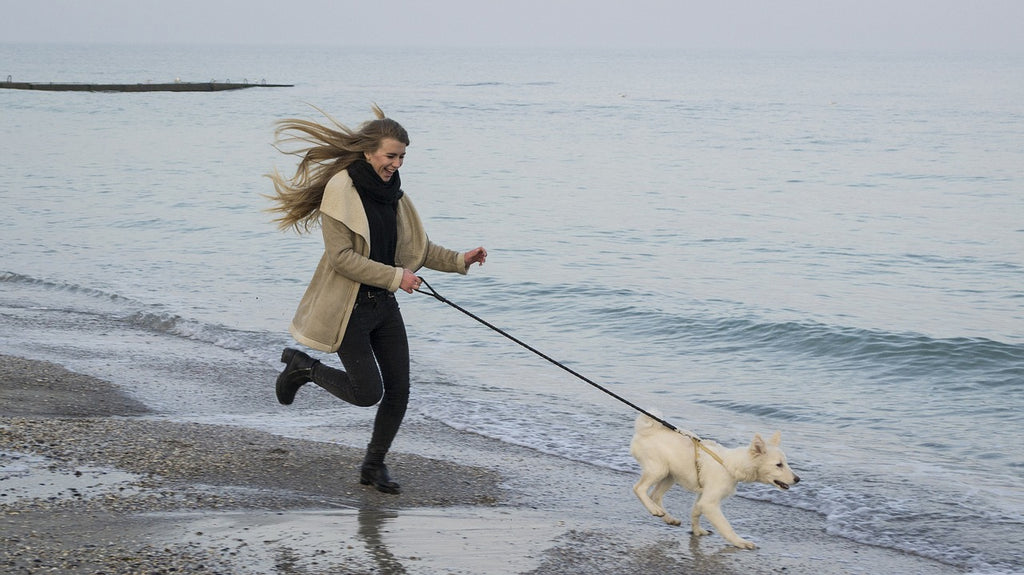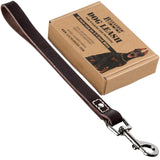Welcome dog lovers! If you are a first time visitor of our growing Leatherberg Dog Community I am sending you the warmest welcome!
In order to bring you only the most valuable tips and tricks, we are collaborating with many US licenced proffessional dog trainers and vets. So if you have't please take a look at our other articles, and soon, much more is coming.
How to safely walk and run with a dog ?
In this blog post we have an interesting topic to cover it is about tips on how to safely walk and run with your dog. So whether you already have a dog or just thinking to buy or adopt a puppy from a shelter this article is just right for you.
I know your time might be pressures so lets start. However before I throw all the golden nuggets on how to safely walk and run your beloved dog, let me reveal what happens to our brains when we exercise and and how it makes us happier.
WHAT TRIGGERS HAPPINESS IN OUR BRAIN WHEN WE EXERCISE?

Most of us are aware of what happens to the body when we exercise. We build more muscle or more stamina. We feel how daily activities like climbing stairs becomes easier if we exercise regularly. When it comes to our brain and mood though, the connection isn’t so clear.
The line around our “endorphins are released” is more something I throw around to sound smart, without really knowing what it means. Here is what actually happens:
If you start exercising, your brain recognises this as a moment of stress. As your heart pressure increases, the brain thinks you are either fighting the enemy or fleeing from it. To protect yourself and your brain from stress, you release a protein called BDNF (Brain-Derived Neurotrophic Factor). This BDNF has a protective and also reparative element to your memory neurons and acts as a reset switch. That’s why we often feel so at ease and things are clear after exercising and eventually happy.
At the same time, endorphins, another chemical to fight stress, is released in your brain. Your endorphins main purpose is this writes researcher McGovern: These endorphins tend to minimise the discomfort of exercise, block the feeling of pain and are even associated with a feeling of euphoria.Overall, there is a lot going on inside our brain and it is in fact oftentimes a lot more active than when we are just sitting down or actually concentrating mentally:
So, BDNF and endorphins are the reasons exercise makes us feel so good. The somewhat scary part is that they have a very similar and addictive behaviour like morphine, heroine or nicotine. The only difference? Well, it’s actually good for us.
THE KEY TO MAXIMISE HAPPINESS THROUGH EXERCISE: DON’T DO MORE, BUT FOCUS ON WHEN
Now here is where it all gets interesting. We know the basic foundations of why exercising makes us happy and what happens inside our brain cells. The most important part to uncover now, is of course how we can trigger this in an optimal and longer lasting way.
A recent study from Penn State University shed some light on the matter and the results are more than surprising. They found that to be more productive and happier on a given work day, it doesn’t matter so much, if you work-out regularly, if you haven’t worked out on that particular day:
“Those who had exercised during the preceding month but not on the day of testing generally did better on the memory test than those who had been sedentary, but did not perform nearly as well as those who had worked out that morning.”
New York Times best-selling author Gretchen Reynolds has written a whole book about the subject matter titled “The first 20 minutes”. To get the highest level of happiness and benefits for health, the key is not to become a professional athlete. On the contrary, a much smaller amount is needed to reach the level where happiness and productivity in every day life peaks:
“The first 20 minutes of moving around, if someone has been really sedentary, provide most of the health benefits. You get prolonged life, reduced disease risk — all of those things come in in the first 20 minutes of being active.”
So really, you can relax and don’t have to be on the look-out for the next killer work-out. All you have to do is get some focused 20 minutes in to get the full happiness boost every day:
“On exercise days, people’s mood significantly improved after exercising. Mood stayed about the same on days they didn’t, with the exception of people’s sense of calm which deteriorated.” (University of Bristol) ( Note for you Tom - this is the end of the content from the article).
How to get into a consistent walking or running (exercise) habit???
Believe it or not, very few people are naturally inclined toward the sweaty, lung-burning, muscle-straining experience of regular exercise. At least, not at first. Like black coffee and red wine, exercise is an acquired taste. One that comes with practice, and that, over time, becomes an enjoyable experience.
What about you? How do you do it? Do you know how you motivate yourself in order to train regularly?

Conscious and unconscious mind
Have you heard about conscious and unconscious mind? And if there is a "battle" among them, the unconscious mind always wins! Unconscious mind is here to protect us against " danger" out there,out of the comfort zone. But remember all the magic happens out of the comfort zone!!!! Imagine your mind as a huge warehouse with plenty of boxes nicely stored. Each box has got a label SAFE- KNOWN. These boxes are your habits, beliefs, thoughts, rituals. They are part of the comfort zone. Mind loves them. But what a warehouse it would be without a warehouseman? And his job is to put labels on boxes. And imagine this.
That one day you decide for a change in your life. Go for walk or run!!!! So there is a new unknown box which has arrived in the warehouse/your mind.And what does warehouse man do now?"What the hell is going on? Running??? Walking??? " ,asks himself. So he puts the label DANGER- UNKNOWN ACTIVITY and he wants to protect us.
How are we going to convince him to switch the label to SAFE - KNOWN activity??? Simply by doing it over and over again until he realises there is no danger associated with walking and running. And can you imagine a greater motivation to go for a walk or run than your beloved furry friend who simply needs it?Who is a part of your family? And I am sure you love your dog absolutely unconditionally and you know your pet deserves only the best!
STEP BY STEP GUIDE (How to safely run with you dog)
Dogs are always eager to spend more time with you, they have plenty of excess energy to burn, and temptation to skip a scheduled sweat session melts away when your furry friend stands at the front door, dog leash in mouth, ready to go.

But before you hit the road you'll need to train your pooch to run or walk with you. And here is easy, step by step guide how to do it:
- Give it a try : dogs need daily exercise for their health and happiness. And again, just like humans, American pets have a pudge problem: an estimated 52% of dogs are overweight or obese. Walking or running with your dog on a dog leash is one way to get you both moving.
- Check with your vet: If you aren't sure whether your dog's fit to run, check with your veterinarian.
- Start out slow: A sedentary person can't just jump off the couch one day and run 5 miles, and neither can a sedentary dog. Too much too soon increases your dog's risk of injury, just as it would a human's. Combine intervals of walking and running, so you have plenty of time for active recovery and catching your breath.
- Wait until they are not too young: "You really should wait until a young dog's growth plates [areas of cartilage near the ends of bones] have started to close, and that time frame really varies by breed and size of dog," says Sharon Wirant, an animal behaviourist with the ASPCA. "A much smaller dog like a Jack Russell Terrier could probably start going on regular runs earlier than a larger dog, like a Great Dane, whose growth plates will take longer to seal up," she says. If your puppy is still growing or hasn't started running with you yet, ask your vet about when it's safe to start.
- Always do your warm up before fast walking or running with your dog: Before you pick up your pace for any workout, be sure you've given yourself—and your dog—at least a few minutes of walking or slow jogging. Warming up can protect you both against injuries. Another warm-up ritual to make a habit: giving your dog a chance to sniff around and do his business. That means fewer stops for pee and poop breaks once you get moving.
- Choose the trails: Running on dirt trails will be easier on your pup's joints and paws than running on asphalt. And as added bonus both you can experience the natural sights, smells, and sounds!
- Don't forget tick protection:You wear bug spray and long socks, and check with your vet to be sure your pet is up-to-date on tick medication.
- Make sure your dog follows basic commands: If a dog does not follow on a walk it is not the right time for a running with your dog. First teach your dog to walk nicely on dog leash, and break the behaviours of stopping to sniff or marking every tree, or racing ahead and pulling you. You are going to find basic commands blog post in April on this webpage.
- Don't let them to pull you: Use a 4- to 6-foot dog leash; anything longer than that can spell trouble on the jogging path, since you want to train your dog to stay by your side. We, at Leatherberg, have designed an incredible dog leash very suitable for training and walking. It is available on Amazon, click the link for more information.
- Take water breaks: It is recommended to stop every 10 minutes, at least until you have an idea of how much water your dog needs—and especially in sunny or hot weather.
- Avoid walking or running when it's too hot: Dogs overheat more easily than humans, since they have heavy fur coats and they don't sweat. So it's important to be careful when it's warm out, and to avoid running in midday heat. If it's too hot for you, it's too hot for your pet.
- Make sure your dog is all right after a walking and running: don't ignore the warning signs like lethargy, weakness, drooling and dark red gums, vomiting, bloody diarrhea, or panting to the point that he can't catch his breath. If your dog stops and refuses to continue, don't force him.
- Give treats after you are both cool down a bit: In the meantime, reward your dog by praising him, petting him, and giving him lots of attention.
- Enjoy every moment of it!!!
Thank you very much for reading this blog post. If you like it and find it useful pls leave a comment.

Have a good day, tell dog lovers in your neighborhood about us and don’t forget to visit Leatherberg store right now. Woof Woof.













